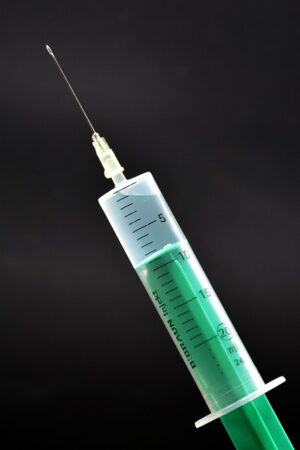Injection molding is an essential production technique for crafting precise plastic parts in high volumes, crucial for industries like automotive, electronics, and consumer goods. It excels in rapid cycling and scalability, reducing time-to-market significantly. The process involves melting material, injecting it into a mold, and then cooling and ejecting the finished product with high accuracy. Precision and consistency are key, achieved through advanced machinery with sensors and feedback systems for temperature control. Quality assurance is maintained by rigorous quality control, regular equipment maintenance, and operator training to ensure adherence to exact specifications. The integration of sophisticated control systems allows for real-time monitoring and adjustments to critical process parameters like injection speed and cooling rate. A robust Quality Management System (QMS) and the application of statistical process control (SPC) further support consistent high-quality output, ensuring compliance with industry standards and regulations. Injection molding's ability to work with various materials and its automation capabilities make it an indispensable tool for modern manufacturing, emphasizing its role in maintaining a sustainable and efficient production process.
In the realm of manufacturing, high-volume production presents a unique set of challenges that require precision, consistency, and a robust quality control framework. This article delves into the intricacies of maintaining consistent quality in large-scale manufacturing through the lens of Injection Molding, a process pivotal to industries spanning automotive to healthcare. We will explore the critical role of precision and consistency, key factors ensuring quality control, and the impact of material selection on production. The integration of advanced technologies like automation and robotics is examined, as well as the importance of equipment maintenance for high output. Strategies for process optimization, workforce training, and quality management systems are highlighted to ensure consistency across production lines. Through a case study, we will witness Injection Molding excellence in action within a high-volume environment. The article also addresses the interplay between Design for Manufacturability (DFM) and Injection Molding, best practices for maintaining dimensional accuracy, lean manufacturing principles, color consistency, tooling’s role, and the application of Statistical Process Control (SPC). Environmental considerations and future trends in Injection Molding technology are also discussed, offering a comprehensive view of the industry’s sustainability and cost efficiency efforts. Global perspectives on quality standards complete this exploration, making it an indispensable read for those seeking to master high-volume manufacturing through Injection Molding.
- Understanding High-Volume Manufacturing through Injection Molding
- The Role of Precision and Consistency in Injection Molding Processes
- Key Factors Ensuring Quality Control in High-Volume Injection Molding
Understanding High-Volume Manufacturing through Injection Molding

Injection molding stands out as a pivotal process in high-volume manufacturing due to its unparalleled efficiency and precision. This manufacturing technique involves injecting molten material into a mold, where it solidifies into the desired shape and size. The versatility of injection molding is evident in its application across various industries, including automotive, electronics, and consumer goods. The process enables mass production with consistent quality, as each component produced is identical to the next, ensuring uniformity and performance across large volumes of products. Moreover, the rapid cycling times associated with injection molding make it particularly suitable for high-volume runs, significantly reducing the time from material injection to finished product extraction. This efficiency not only accelerates production lines but also minimizes downtime, contributing to a streamlined manufacturing process that can meet the stringent demands of large-scale distribution and retail markets.
The intricacies of injection molding lie in its ability to accommodate a diverse array of materials, such as plastics, metals, and composites, allowing for complex geometries and fine details in the final product. The automated nature of the process, from the injection unit to the cooling and ejection mechanisms, ensures a high level of control over the manufacturing process, resulting in a consistent quality that is critical for high-volume production. The integration of advanced technologies, like automation and predictive analytics, further enhances the precision and efficiency of injection molding, making it a cornerstone of modern manufacturing environments striving for excellence and scalability.
The Role of Precision and Consistency in Injection Molding Processes

Injection molding stands as a cornerstone in the realm of high-volume manufacturing, where precision and consistency are paramount to producing quality products at scale. The intricate dance of melting raw material, injecting it into precise molds, and then cooling and ejecting the finished product must be executed with near-perfect accuracy each time. The process begins with the meticulous preparation of the mold, ensuring its surface is free from defects and perfectly aligned to prevent warping or misalignment in the final part. The precision temperature control during the melting and cooling phases is critical; too hot, and the plastic degrades; too cold, and the part may not release cleanly. This delicate balance requires advanced machinery equipped with sensors and feedback systems to maintain consistent temperatures within fractions of a degree Celsius. Moreover, the injection units themselves must be calibrated to deliver the exact amount of material required for each mold, ensuring that every part has the correct dimensions and integrity. The consistency across thousands or even millions of parts is achieved through stringent quality control measures, regular maintenance of equipment, and continuous operator training. These practices minimize variability in the final products, thereby maintaining the high standards expected in industries ranging from automotive to medical devices, where tolerances are often measured in micrometers. The overarching goal in injection molding is to produce parts that meet exact specifications every single time, showcasing the synergy between technological innovation and skilled craftsmanship in this sophisticated manufacturing process.
Key Factors Ensuring Quality Control in High-Volume Injection Molding

Injection molding is a manufacturing process that consistently produces high-volume, precision plastic parts across various industries. Ensuring quality control in this context requires a multifaceted approach that addresses several key factors. The first factor is the meticulous maintenance of the injection molding machines themselves. Regular calibration and servicing are imperative to maintain the precision required for defect-free parts. This includes monitoring the temperature and pressure within the machine, which directly affects part quality. Another crucial aspect is the stringent control of material quality, as the input directly dictates the output. High-quality raw materials must be consistently supplied to ensure that each part produced meets the necessary specifications.
Process parameters such as injection speed, mold temperature, and cooling rate are finely tuned through precise control systems. These systems automate the process, reducing the potential for human error. Additionally, real-time monitoring and data collection facilitate continuous improvement by providing insights into production trends. This allows manufacturers to quickly identify and correct any deviations from ideal parameters, thereby maintaining high standards of quality. Furthermore, an effective quality management system (QMS) is essential for ongoing compliance with industry standards and regulations. The QMS ensures that every stage of the injection molding process adheres to best practices, resulting in a consistent and reliable end product. Implementing robust statistical process control (SPC) techniques further enhances quality assurance by detecting and addressing potential issues early in the production cycle. Through these comprehensive measures, manufacturers can sustain high-quality output even at the highest volumes of production in injection molding.
Injection molding stands as a cornerstone in high-volume manufacturing, where precision and consistency are paramount. This article has illuminated the critical factors that contribute to the delivery of consistent quality within this demanding sector. By adhering to stringent quality control measures and leveraging the intricacies of injection molding technology, manufacturers can produce a wide array of products with unwavering reliability. The insights provided underscore the importance of a systematic approach to achieving excellence in high-volume production, ensuring that each component meets the highest standards set forth by industry demands.
